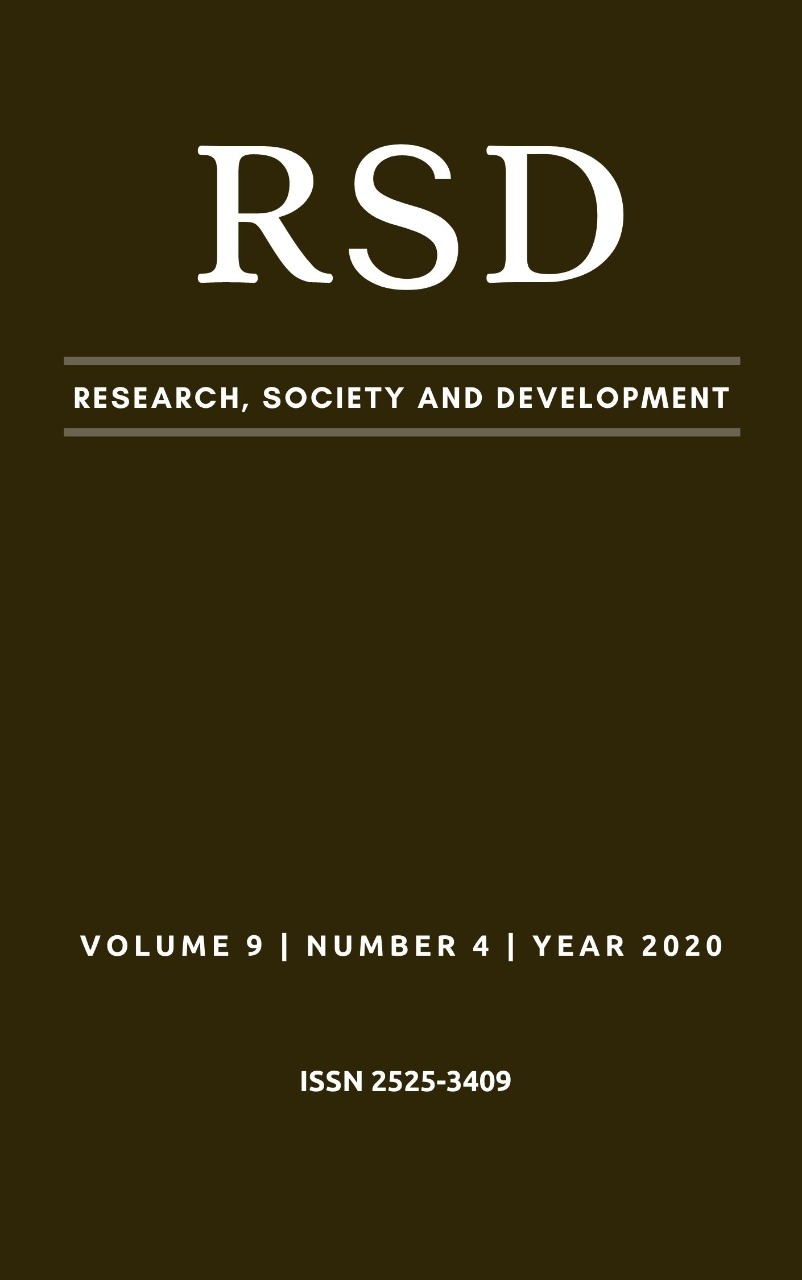Investigação sobre a automedicação dos estudantes do curso de medicina de uma Instituição de Ensino Superior
DOI:
https://doi.org/10.33448/rsd-v9i4.2836Palavras-chave:
automedicação, estudantes, medicina, medicamentosResumo
Avaliar as práticas de automedicação em estudantes de medicina, bem como os fatores, a frequência e quais são os medicamentos mais frequentes. Método: estudo transversal quali-quantitativo, no qual cerca de 200 alunos responderam um questionário contendo questões de múltipla escolha sobre a prática de automedicação. Para análise de estatística dos dados foi feito o teste de qui-quadrado e utilizado índice de confiança de 95%. Dos 146 estudantes que administraram algum medicamento neste período, 61 (41,7%) relataram que o medicamento não foi prescrito por médico/dentista. A prevalência da automedicação entre os estudantes que administraram algum medicamento nos últimos 6 meses foi de 88%. Os medicamentos mais utilizados foram os analgésicos e relaxantes musculares. Vale ressaltar o uso indiscriminado de antibióticos, sendo que uma das maiores e perigosas consequências é a resistência bacteriana, que impede a eficácia do tratamento e a demora na cura do paciente. O índice de automedicação entre os estudantes foi alto, semelhante a outros estudos observados. Essa temática necessita de práticas de intervenção das estruturas educacionais acadêmicas, as quais precisam estar fundamentadas em métodos e protocolos efetivos que enfoquem favorecer aos estudantes de Medicina, alertando-os sobre os risco da automedicação.
Referências
Albuquerque, L. et al (2015). Avaliando a Automedicação em estudantes do Curso de Medicina da Universidade Federal da Paraíba. Rev Med e Pesquisa, 1, 39-50. Recuperado de: https://periodicos.ufpb.br/
Alfredo, N., & Cavalet, D., & Kappes, D., S. Silva, D.(1998). O estudante de medicina e o estresse acadêmico. Rev. Med. PUCRS, 8 (1), 6-12. Recuperado de: http://bases.bireme.br/cgibin/wxislind.exe/iah/online/?IsisScript=iah/iah.xis&src=google&base=LILACS&lang=p&nextAction=lnk&exprSearch=213447&indexSearch=ID
Arrais, P., D., & Coelho, H., L, Batista, M., D, Carvalho, M., L, Righi, R,. E, Arnau J. M. (1997). Perfil da automedicação no Brasil. Rev. Saúde Pública, 31(1), 71-77. Doi: 10.1590/S0034-89101997000100010
Badiger, S. et al. (2015). Self-medication patterns among medical students in South India. Australas Med J, 5 (4), 217-220. doi: 10.4066/AMJ.2012.1007
Botti, N. & Lima, A. & Simões, W.(2106). Uso de substâncias psicoativas entre acadêmicos de enfermagem da Universidade Católica de Minas Gerais. Rev. Eletrônica Saúde Mental Álcool Drogas. 6, 1-13. Recuperado de: http://pepsic.bvsalud.org/scielo.php?script=sci_arttext&pid=S1806-69762010000100013&lng=pt&tlng=pt.
Campos, J., M. et al. (1985). Prescrição de medicamentos por balconistas de 72 farmácias de Belo Horizonte/MG. J. Pediatr, 59, 307-312. Recuperado de: http://bases.bireme.br/cgibin/wxislind.exe/iah/online/?IsisScript=iah/iah.xis&src=google&base=LILACS&lang=p&nextAction=lnk&exprSearch=28991&indexSearch=ID
Du, Y. & Knopf, H. (2009). Self-medication among children and adolescents in Germany: results of the National Health Survey for Children and Adolescents (KiGGS). British Journal of Clinical Pharmacology, 68 (4), 599-608. doi: 10.1111/j.1365-2125.2009.03477.x.
Fonseca, F. et al. (2010) Frequência de automedicação entre acadêmicos de faculdade de medicina. Rev. Diagn Tratamento, 15 (2),53-57. Recuperado de: http://files.bvs.br/upload/S/1413-9979/2010/v15n2/a53-57.pdf
Furtado, E., & Falcone, E.,M. &Clark, C. (2003). Avaliação do estresse e das habilidades sociais na experiência acadêmica de estudantes de medicina de uma universidade do Rio de Janeiro. Interação em Psicologia. 7(2), 43-51.doi: 10.5380/psi.v7i2.3222
Lipp, M. (1996) Stress: Conceitos básicos. Pesquisas sobre stress no Brasil: Saúde, ocupações e grupos de risco, São Paulo, Papirus, 17-3. Recuperado de: http://www.scielo.br/scielo.php?script=sci_nlinks&ref=000109&pid=S01041169200400010000300004&lng=pt
Masson, W.(2012). Automedicação entre acadêmicos do curso de Medicina da Faculdade de Medicina de Marília, São Paulo. Rev. Bras. Pesq. Saúde, 14(4), 82-89.doi: 10.21722/rbps.v14i4.5123
Meyer, C. & Guimarães, A. C. A. & Machado, Z., & Parcias, S. R. (2012). Qualidade de vida e estresse ocupacional em estudantes de medicina. Rev Bras Educ Méd; 36(4),489-98. doi: 0.1590/S0100-55022012000600007
Moraes, A. & Araujo, N. & Braga, T. (2016). Automedicação: revisando a literatura sobre a resistencia bacteriana aos antibióticos. Rev Eletr. Estácio Saúde, 5, 122-132. Recuperado de: revistaadmmade.estacio.br
Nascimento, M.,C.(2003) Medicamentos: ameaça ou apoio à saúde?: vantagens e perigos do uso de produtos da indústria farmacêutica mais consumidos no Brasil: vitaminas, analgésicos, antibióticos e psicotrópicos. Rio de Janeiro: Vieira e Lent ; 200. Recuperado de: http://bases.bireme.br/cgibin/wxislind.exe/iah/online/?IsisScript=iah/iah.xis&src=google&base=LILACS&lang=p&nextAction=lnk&exprSearch=348872&indexSearch=ID
Neto, J.A. C. & Sirimarco, M. T. & Choi, C. M. K. & Barreto, A. U,& Souza, J. B. (2007). Automedicação entre Estudantes de Faculdade de Medicina da Universidade Federal de Juiz de Fora. HU Revista, 32(3), 59-64. Recuperado de: periódicos.ufjf.br
Pereira, F. et al.(2007). Self-medication in children and adolescents. J Pediatr, Rio de Janeiro, 83 (5), 454-458. doi:10.2223/JPED.1703
Roberto, A., & Almeida, A. (2011). Saúde mental de estudantes de medicina. Acta Med Port, (2), 279-286. Recuperado de: https://www.actamedicaportuguesa.com/revista/index.php/amp/article/download/1490/1076
Tomasi, E. et al. (2007). Condições de trabalho e automedicação em profissionais da rede básica de saúde da zona urbana de Pelotas, RS. Rev. bras. Epidemiol, 10 (1), 66-74. doi: 10.1590/S1415-790X2007000100008
Downloads
Publicado
Edição
Seção
Licença
Autores que publicam nesta revista concordam com os seguintes termos:
1) Autores mantém os direitos autorais e concedem à revista o direito de primeira publicação, com o trabalho simultaneamente licenciado sob a Licença Creative Commons Attribution que permite o compartilhamento do trabalho com reconhecimento da autoria e publicação inicial nesta revista.
2) Autores têm autorização para assumir contratos adicionais separadamente, para distribuição não-exclusiva da versão do trabalho publicada nesta revista (ex.: publicar em repositório institucional ou como capítulo de livro), com reconhecimento de autoria e publicação inicial nesta revista.
3) Autores têm permissão e são estimulados a publicar e distribuir seu trabalho online (ex.: em repositórios institucionais ou na sua página pessoal) a qualquer ponto antes ou durante o processo editorial, já que isso pode gerar alterações produtivas, bem como aumentar o impacto e a citação do trabalho publicado.


